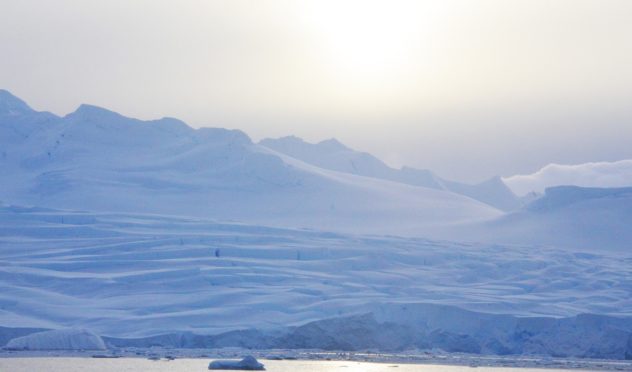Vocabulary:
- boundary /BOUN-duh-ree/
- scrutinize /SKROOT-n-ahyz/
- isolated /AHY-suh-ley-tid/
- composition /kom-puh-ZISH-uh n/
- distinctness /dih-STINGKT-nes/
[noun] — a real or imagined line that marks the edge or limit of something
Mount Everest marks the boundary between China and Nepal.
[verb] — to examine something very carefully in order to discover information
They scrutinized all canned goods to see if they are poisonous as written in the report.
[adjective] — not near to other places
The farm is isolated; the nearest house is 25 kilometers away.
[noun] — the parts, substances, etc. that something is made of
The chemical composition of water is two hydrogen atoms and one oxygen atom.
[noun] — the quality of being not alike
There are several distinctness between the process before and now.
Scientists and researchers said they have determined the world’s cleanest air, located over the Southern Ocean in Antarctica. Professor Sonia Kreidenweis and her team from Colorado State University presumed that the air on the Southern Ocean would be least afflicted by human activity from the continents of the world. The boundary layer air, which bolsters the lower clouds off the Southern Ocean, was clear from aerosol particles developed by human activity. These include burning fossil fuels, growing crops, fertilizer production, and wastewater disposal. Air pollution, which is considered a global health crisis by the World Health Organization (WHO), is caused by aerosols that are cascading in the air, affecting millions of people each year.
The researchers decided to scrutinize the air components and its origin using the bacteria in the air as a diagnostic tool to interpret the properties of the lower atmosphere. “The aerosols controlling the properties of SO (Southern Ocean) clouds are strongly linked to ocean biological processes, and that Antarctica appears to be isolated from southward dispersal of microorganisms and nutrient deposition from southern continents”, Thomas Hill, research scientist and co-author of the study, stated. He also added, “Overall, it suggests that the SO is one of very few places on Earth that has been minimally affected by anthropogenic activities”. Scientists investigated the composition of airborne microbes and sampled the air in the marine boundary level, traveling south to the Antarctic ice edge from Tasmania, Australia. Jun Uetake, source tracking and wind back trajectories scientist, identified the microbes’ origins were from the ocean. Hence, the researchers concluded that aerosols from distant landmasses and human activities were not going south and into the air. They also mention that the results show an evident distinctness to all other studies from oceans both in the northern hemisphere and subtropics.
The researchers decided to scrutinize the air components and its origin using the bacteria in the air as a diagnostic tool to interpret the properties of the lower atmosphere. “The aerosols controlling the properties of SO (Southern Ocean) clouds are strongly linked to ocean biological processes, and that Antarctica appears to be isolated from southward dispersal of microorganisms and nutrient deposition from southern continents”, Thomas Hill, research scientist and co-author of the study, stated. He also added, “Overall, it suggests that the SO is one of very few places on Earth that has been minimally affected by anthropogenic activities”. Scientists investigated the composition of airborne microbes and sampled the air in the marine boundary level, traveling south to the Antarctic ice edge from Tasmania, Australia. Jun Uetake, source tracking and wind back trajectories scientist, identified the microbes’ origins were from the ocean. Hence, the researchers concluded that aerosols from distant landmasses and human activities were not going south and into the air. They also mention that the results show an evident distinctness to all other studies from oceans both in the northern hemisphere and subtropics.
True or False:
- The World Health Organization did not consider air pollution as a global health crisis.
- Professor Sonia Kreidenweis and her team from Orlando State University assumed that the air on the Southern Ocean would be least afflicted by human activity and dust from the continents of the world.
- Scientists and researchers determined the world’s cleanest air, located over the Indian Ocean in Antarctica.
- Jun Uetake identified that the microbes’ origins were from the ocean.
- The researchers concluded that aerosols from distant landmasses and human activities were going north and into the air.
Discussion Questions:
- What is your opinion about this new discovery? Elaborate your answer.
- Do you think air pollution has a huge impact on our health? Why or why not?
- What are the things or activities that cause air pollution? Please cite examples.
- What is your government’s stand on climate change?
- What do you do to lessen air pollution? Please give three examples.
Express Your Opinion:
- “Let the clean air blow the cobwebs from your body. Air is medicine.” – Lillian Russell
- “Because no matter who we are or where we come from, we’re all entitled to the basic human rights of clean air to breathe, clean water to drink, and healthy land to call home.” – Martin Luther King III
- “Climate change is a terrible problem, and it absolutely needs to be solved. It deserves to be a huge priority.” – Bill Gates
